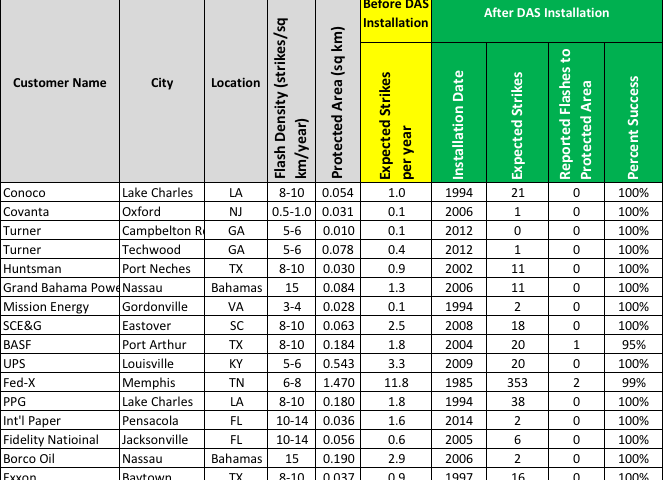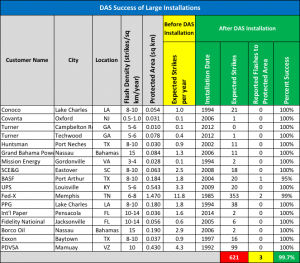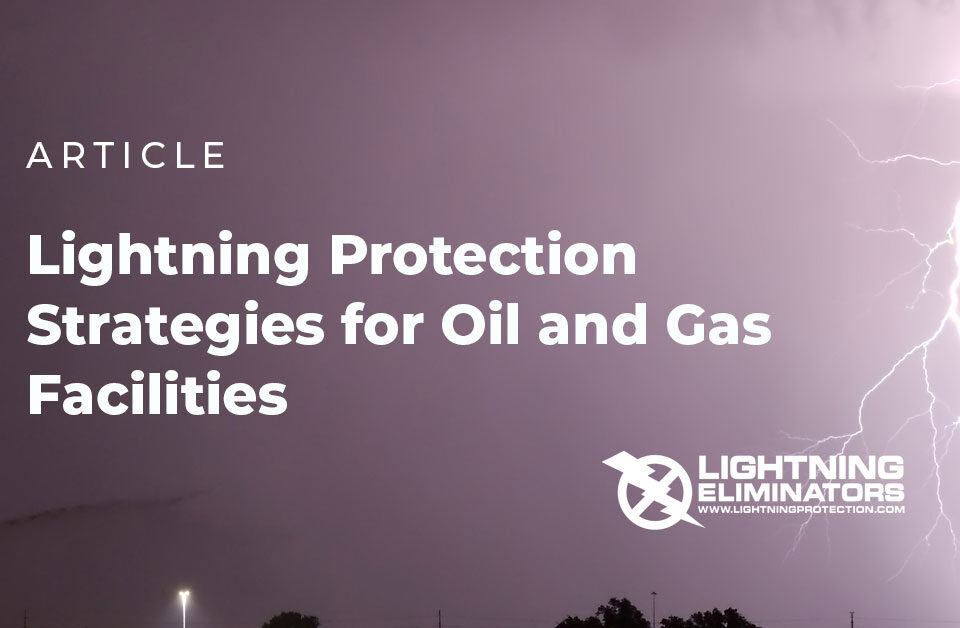- We Prevent Lightning Related Problems.

Damage Caused by Lightning Strikes
March 14, 2017
Grounding Rod Can Save Your Life
July 29, 2017Client Lightning Protection Study – 1985 – 2017

Taken from – Large Installation Lightning Protection Summary Technical Specifications – By Darwin N. Sletten, P.E.
Introduction
For over 40 years LEC has been providing Lightning Protection solutions by installing Dissipation Array Systems (DAS) to prevent lightning related damage to sites varying in size from a single tower to an area close to 1.5 square kilometers.
This paper reviews the customers and sites that have been protected by a DAS from 1992 through today. To calculate how effective a DAS has been we calculate the number of strikes that the protected area would have received without DAS. This calculated number of strikes is compared with the reported number of strikes to provide an indication of the effectiveness of a DAS.
Lightning flash density
The lightning flash density (flash density) is defined as the yearly number of flashes to ground per square kilometer. The flash density number for protected areas in the United States is determined from the NFPA Average U.S. Lightning Flash Density Map (flashes per square kilometer per year).
Some sites are in an area where there is a range of yearly strikes to a square kilometer; such as 8 – 10 strikes per square kilometer per year. For analysis purposes, the greater number in the range was used as the flash density.
Success Chart Summary
The chart below summarizes the success that DAS has had over the years in our largest installations. The summary includes the following facts.
- Over 15 years LEC DAS have been 99.7% effective in Eliminating Lightning at some of the world’s largest companies.
- DAS has blocked over 620 potentially disastrous lightning strikes
- DAS protected areas had only 3 strikes over 15 years. Both cases had extenuating circumstances.

Site Comments
The calculations of the protected area are based on a well maintained and inspected DAS. Where there have been reported strikes to the protection area, this paper provides comments on the site as well as the condition of the DAS or unusual circumstances that led to a degradation of the ability of the DAS to function as originally designed.
Federal Express, Memphis, TN
This site was originally protected in 1985 and has been modified numerous times as the Federal Express hub footprint has grown. As the hub has grown, the location of some of the airplane gates have changed with Federal Express moving them as required. Usually LEC is notified about these gate changes when they happen. LEC has always been advised to the addition of new buildings.
Because of this lag in installation of gates and construction of new buildings there have been two reported lightning events at the site. Each report has been investigated and found that there was no direct lightning strike to the protected area. The ensuing investigation found that the system had not been fully functional due to bonding, grounding or maintenance issues. The satisfaction of Federal Express with the LEC designed lightning protection system is evident by their continued use of the system as the Federal Express package delivery system expands.
BASF, Port Arthur
There have been no reported direct lightning strikes to the protected area since 2005.
Summary
Lightning Protection
Using the analysis method described above, the attached table is of the largest sites LEC has protected from direct lightning strikes since 1985.

